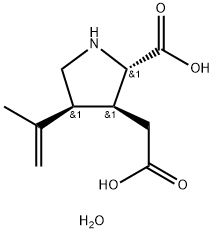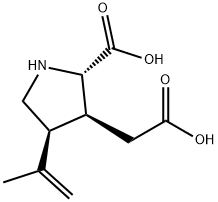≥98%(HPLC),fromDigeneasimplex , 58002-62-3
Synonym(s):
2-Carboxy-3-carboxymethyl-4-isopropenylpyrrolidine
| Pack Size | Price | Stock | Quantity |
| 10mg | RMB3100.42 | In Stock |
|
| 50mg | RMB11143.98 | In Stock |
|
| others | Enquire |
PRODUCT Properties
| Melting point: | 250-252°C |
| RTECS | UX9665250 |
| storage temp. | 2-8°C |
| solubility | H2O: >10 mg/mL |
| form | solid |
| color | white |
| biological source | Digenea simplex |
| Water Solubility | H2O: soluble |
| Sensitive | Light Sensitive |
Description and Uses
(−)-(α)-Kainic acid is a cyclic analog of L-glutamate originally isolated from D. simplex that has neuroexcitatory activities. It binds to the homomeric kainate receptors GluK1, GluK2, GluK3, GluK4, and GluK5 (Kis = 75.9, 12.7, 32.8, 4.7, and 15 nM, respectively). (−)-(α)-Kainic acid (5 mM) induces calcium influx and membrane depolarization, as well as glutamate release, in rat brain synaptosomes. It induces chromatin condensation and nuclear membrane fragmentation, markers of apoptosis, in primary neonatal cerebellar granule neurons when used at a concentration of 100 μM. Intracerebroventricular administration of (−)-(α)-kainic acid induces convulsive behavior in rats (ED50 = 0.51 nmol/animal) and induces seizures in mice with a 50% convulsive dose (CD50) value of 0.39 nmol/animal. It has been commonly used to induce seizures in rodents.
Kainic acid monohydrate has been used:
- As a convulsant to induce epileptogenesis and epilepsy in mice.
- To stimulate in vitro excitotoxic trauma in spiral ganglion neurons on inner hair cells.
- To induce seizures in rat model.
- To induce status epilepticus in adult male Wistar rats.



